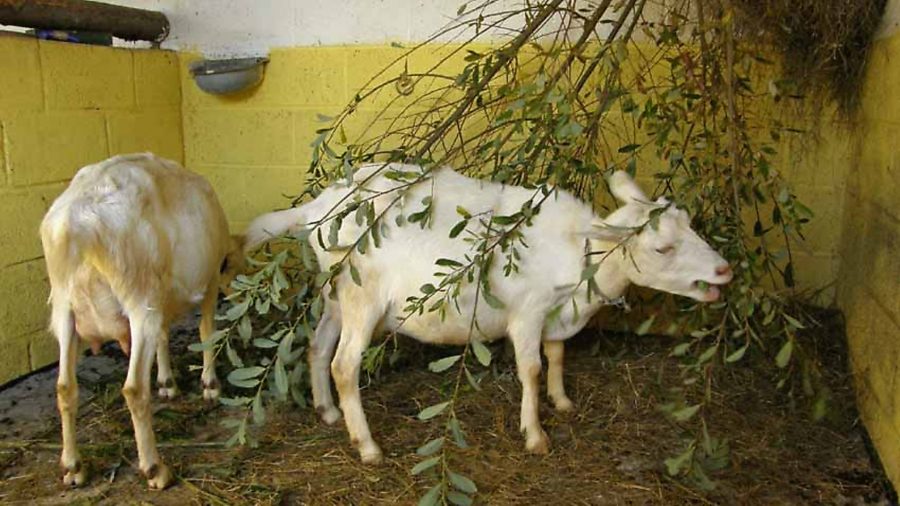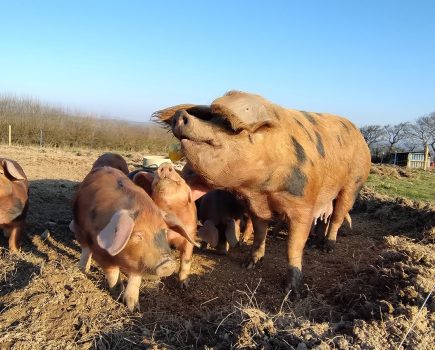Willow is the smallholder’s all-rounder tree. Judit Keleman reports
Willow is the smallholder’s all-rounder tree. Judit Keleman reports “May I ever be in as good spirits as a willow!… They never despair.” (Henry David Thoreau) Everyone knows that oaks have more associated insects than any other native tree species, but which tree is the second highest? It is the willow and it does not lose by much! (my husband) I was very relieved this spring when the weather turned warmer and the grass started growing, as I was running out of willow branches to feed to our livestock. The willow fedge (a living fence/hedge) bordering our garden played a major role in keeping our sheep and goats well fed this spring. I planted the fedge to act as a ‘safety net’ for my young children when we moved to our smallholding nine years ago, as there is a very steep slope at the edge of the garden. The potager, our vegetable-cum-amenity garden, is surrounded by very vigorous, strong common osier, while the shrubbery is bordered by a beautiful coral bark willow fedge. The willows are intertwined with each-other forming a continuous barrier of main branches from which a myriad of shoots race to the sky. These can reach 2m in length within a year and the trunks can achieve fire-wood girth within 4-5 years! Every year this luxuriant growth must be pruned back, which is quite a job. However, the cut material has many uses which makes the task less daunting. Hedge and Fedge: living structures The living willow fence around our garden is not just a safety barrier but it also acts as a windbreak and it stabilises the slope at the edge of the garden. During the first winter after establishment, I bent and weaved together the strongest rods creating a wavy, strong border. The remaining branches were cut back hard. Many rods grew out of this framework. Every year, most of these are cut back as close to the fedge framework as possible, to facilitate the development of strong new rods in spring. In 2010 we planted 400m of double-row hedge on our smallholding (six plants to the metre). As more than 60m of this was on wet, peaty ground, I cut willow rods (40-50cm long, 1.5-3cm diameter) and stuck these through black plastic into the ground. While a number of the other, expensive saplings planted along the rest of the hedge died (much of which were replaced later, by … willows!), all of the Salix cuttings took. Willow rods are brilliant for creating living artwork and bowers etc; we had great fun making several ‘tents’ using this bendable material. It is easy for kids to use it to make little dens. Fodder Until recently, we sometimes cut a few branches as a treat for our animals, and pruned the rest during the dormant season. However, because of the last two extremely wet years and the paucity of fodder this spring, the yearly growth of willow became an important element of our livestock’s feed. Now I start pruning the willows before leaf-fall and give the sheep and the goats (and if they are lucky, the ponies) large bundles of it. I prune one side of the fedge, leaving the other side intact to act as a windbreak protecting the garden from winter gales. The cut material is a favourite delicacy for the sheep and the goats, and it keeps them busy stripping the branches of the leaves and bark, reducing significantly the amount of other food they consume. Last autumn the weather was so dreadful that the milk production of the goats dropped dramatically as they refused to leave their shelter to graze, and the lambs also looked miserable. A dry shed and regular supply of willow fodder soon restored the goats’ milk supply and the condition of the lambs. Instead of cutting the remaining willow branches before bud break, I wait until the leaves are out to use the cut rods as fodder. This spring, grass growth did not start as usual (in March), and the willow sprang into leaf weeks before I could even consider letting the goats out, providing sorely needed fresh fodder for the newly kidded does. The kids joined the ‘feeding frenzy’ by the time they were 6-7 days old, eating the fresh leaves with gusto, helping the development of their rumen and getting them used to browsing fresh vegetation. Because we have lots of willow, there is plenty of material for our hungry livestock. For 10 weeks I cut a huge armful in the morning and one in the evening, providing most of the food for our goats and sheep. In late April most Irish farmers were out of fodder and had to import forage from abroad. I was fortunate to be able to feed my stock with first quality fodder straight from the farm! Willow leaves and branches are very nutritious. Research carried out in New Zealand showed that willow and poplar leaves had more digestible dry matter (56-68%) than pasture hay (50-53%), on par with lucerne hay (57-65%), however the protein content was lower (5-17%) than that of pasture or lucerne hay (20-25%). (Hort. Research, Otago & Hawkes Bay Regional Council). Waste-water treatment We planted a triple row of willows from cuttings along the drain running below the raised percolation area of our domestic waste-water system. The willows grew furiously and soon became tree-sized. We do not prune these plants as we do with the fedge, but allow the goats to strip the branches in the autumn. The goats have a wonderfully subtle way of getting at the leaves: they run their necks along a branch, bending it down, and then browse the leaves. They even co-operate, one standing on the back of the other to reach a desirable branch. We cut the larger branches down for them. After the goats finish their feast, we cut the remaining material close to the ground. This takes biomass away and encourages strong re-growth, thus the up-take of more of the potential effluent from the percolation area. Willows are now being used in creating zero-discharge sewage treatment systems: a large ‘pond’ is excavated (about 200 m sq for a domestic house), lined so that no water can run out, backfilled with soil and planted with willows. The effluent from the septic tank is let into this pond, which has to be large enough to take up all precipitation falling on it too. The willows, through evapo-transpiration, eliminate the water and also take up the nutrients. The rods have to be harvested periodically. This is an environmentally benign waste-water treatment system, with the added benefit of creating a wildlife habitat! Plant supports, edging for beds, hurdles The flexible willow rods are perfect for weaving edging around flower-beds in the garden. I use this often, as it suits the style of our garden. As the willow rods will not last more than three years, these need to be replaced. Weaving willow for a robust edging is best carried out during the winter, when the plants in the bed are dormant and can be cut back and the willow rods are at their most bendable. During the vegetative season, you need to strip the willow of its leaves, and the rods break quite easily when bent. I also use willow to weave around the base and mid-section of the tepees put in for sweet peas, which makes the support system much stronger. This weaving has to be replaced every year or two, but it is a pleasant job taking no more than 30 minutes for each tepee (I use hazel rods for the uprights as these last for longer). Windbreaks can be successfully woven around poles stuck in the ground using cut rods. Firewood and kindling The willow fedge and hedge is pruned every year (some years we do not get around cutting back all 200m+ of hedge, which causes no harm, just thicker and longer rods which are valuable for making bowers or green furniture). The trunks grow in girth rapidly and become usable as firewood within 4-5 years. Willow is not great for burning, unless it is well seasoned. We stack the firewood in situ for a year and then bring it under cover for another year. A number of shoots grow back from the stumps. For reasonable sized firewood within a couple of years, prune out the weak shoots leaving the strongest which, if they are pollarded (cut at about 1.2-1.5m height), will provide perfect size wood for the fire. The harvested rods, if left for a few months to dry, make wonderful kindling. Conclusion Willows are attractive, resilient and undemanding trees. Planting and managing willow hedge or a small copse is a good step towards agroforestry and fits well into a permaculture plan. They require little attention and provide great and diverse return for the invested time and space. They helps build resilience in the unpredictable weather conditions. The uses described above are only some of the many benefits willows can bring to farming (see also panel), which we currently use – but I would love to make baskets also! During our smallholding/self sufficiency courses, we introduce the participants to the versatility of this species, and many of them come back armed with secateurs to take cuttings home! I urge every smallholder to consider planting some willow to provide many benefits, also adding a tough, good-looking tree to the farm. Uses for willow • Many items can be made from willows, from baskets, hurdles, crab and lobster pots to small boats (coracles). • Because of its flexibility, willow makes an excellent living fence (Fedge) and it can be bent into wonderful living art as well as ‘green’ furniture. Cricket bats are made from the wood of Salix alba var. coerulea. It was used as part of wattle and daub, for making walls, in which wooden strips woven together (wattle) is daubed with a sticky material made from mixing wet clay, dung and straw. This construction method has been used for at least 6,000 years, and is still an important technique in many parts of the world. It is becoming fashionable again… • It has powerful roots which make this tree widely used in the stabilisation of river banks (and any other steep slopes such as the edge of our garden!), it is great as windbreak, and as it can take up a lot of nutrients and withstands wet conditions, it is used in constructed wetlands and more recently, as zero-discharge willow beds to deal with the effluent from septic tanks. • Willow bark contains salicin, a powerful anti-inflammatory agent close to aspirin. It is bitter (try chewing a piece of bark!), but livestock browse it happily. • It is now widely promoted as biofuel and it can be used to make charcoal. • FODDER! * Judit and her family run smallholding courses on Harmony Farm in Ireland. See www.harmonyfarming.wordpress.com








